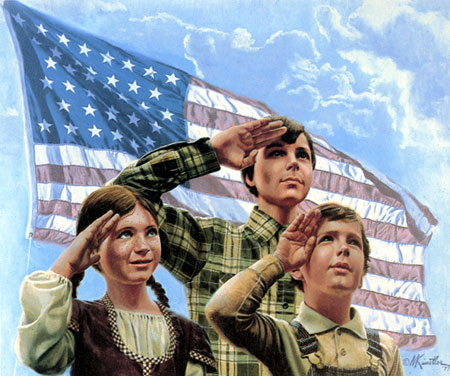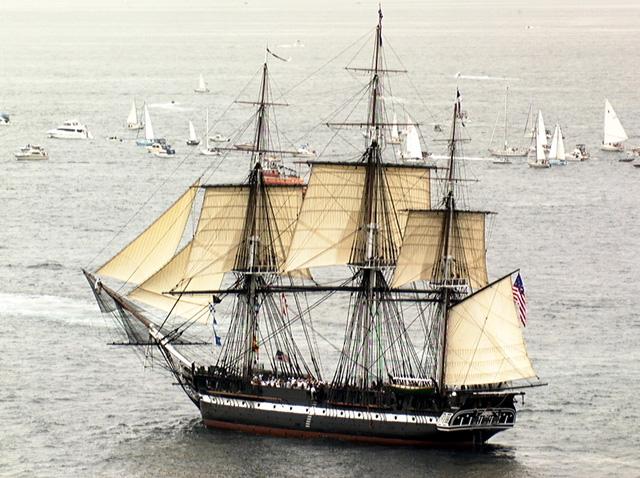|
Where Are The Old Naval Ships? 
The first Bonhomme Richard, formerly Duc de Durae, was a frigate built in France for the East India Company, in 1765, for service between France and the Orient. She was placed at the disposal of John Paul Jones on 4 February 1779 by the French King and renamed Bonhomme Richard.
On 19 June 1779 Bonhomme Richard sailed from L'Orient accompanied by Alliance, Pallas, Vengeance, and Cerf, with troop transports and merchant vessels under convoy to Bordeaux, and to cruise against the British in the Bay of Biscay. Forced to return to port for repair, the squadron sailed again 14 August 1779. Going northwest around the west coast of the British Isles into the North Sea and then down the east coast, the squadron took 16 merchant vessels as prizes.
On 23 September 1779 they encountered the Baltic Fleet of 41 sail under convoy of HMS Serapis (44) and Countess of Scarborough (22) near Flamborough Head. After 1800, Bonhomme Richard engaged Serapis and a bitter engagement ensued during the next four hours before Serapis struck her colors. Bonhomme Richard, shattered, on fire, and leaking badly defied all efforts to save her and sank at 1100 on 25 September 1779. John Paul Jones sailed the captured Serapis to Holland for repairs.        

The third USS Delaware, a ship-of-the-line, was laid down at Norfolk Navy Yard in August 1817 and launched 21 October 1820. She was roofed over and kept at the yard in ordinary until on 27 March 1827, when she was ordered repaired and fitted for sea. Delaware put to sea 10 February 1828 under the command of Captain J. Downs to become the flagship of Commodore W. M. Crane in the Mediterranean. Arriving at Algeciras Bay, Spain, 23 March, she served in the interests of American commerce and diplomacy in that area until returning to Norfolk 2 January 1830. Delaware was decommissioned 10 February 1830, and lay in ordinary at Norfolk until 1833. Recommissioned 15 July 1833, she received President Jackson on board 29 July, firing a 24-gun salute at both his arrival and departure. The following day she set sail for the Mediterranean where she served as flagship for Commodore D. T. Patterson and cruised on goodwill visits and for the protection of the rights and property of American citizens until her return to Hampton Roads, 16 February 1836. She was placed in ordinary from 10 March 1836 until recommissioned 7 May 1841 for local operations from Norfolk. Delaware sailed 1 November 1841 for a tour of duty on the Brazil Station as flagship for Commodore C. Morris. She patrolled the coasts of Brazil, Uruguay, and Argentina to represent American interests during political unrest in those countries. On 19 February 1843 she sailed from Rio de Janeiro for another cruise in the Mediterranean. Delaware returned to Hampton Roads 4 March 1844 and was decommissioned at Norfolk Navy Yard on the 22d. Still in ordinary there in 1861, she was burned 20 April along with other ships and the yard facilities to prevent their falling into Confederate hands.        

The first USS Constellation , a frigate authorized by congressional enactment of 27 March 1794, was the design of naval constructors, J. Humphreys and J. Fox, whose plans were altered in the execution by the builder, D. Stodder, and supervisor of construction, Captain T. Truxtun. She was built at the Sterrett Shipyard, Baltimore, Md., and was launched on 7 September 1797, the second of the United States frigates to go down the ways. Constellation 's first cruise, from June through August 1798, in which she convoyed merchant ships to sea, showed admirable qualities, including a sailing speed which could win her the nickname "Yankee Race Horse," and ensure an outstanding career of service. In the grave days of World War II President F. D. Roosevelt looked for a symbol of American glory to inspire American citizens to the task which lay ahead. One symbol was Constellation , recommissioned in August 1940, and classified IX-20 on 8 January 1941. From 1941-43 she was assigned as the shore-based relief flagship of Commander-in-Chief, U.S. Atlantic Fleet, and later of Commander, Battleship Division Five, Atlantic Fleet. Thus she rendered her final service to the Fleet. Plans to memorialize Constellation brought her to Boston in October 1946 but lack of funds delayed the project. Decommissioned for the last time on 4 February 1955, this, the then-oldest ship in the United States Navy, arrived at Baltimore on 9 August 1955, was stricken from the Navy List on 15 August 1955, and transferred to a patriotic group of citizens who are restoring her as a visible evidence of the United States' enduring need of the sea.        

The fourth Connecticut (BB-18) was launched 29 September 1904 by New York Navy Yard; sponsored by Miss A. Welles, granddaughter of Gideon Welles, Secretary of the Navy during the Civil War; and commissioned 29 September 1906, Captain W. Swift in command. Joining the Atlantic Fleet, Connecticut became flagship 16 April 1907, and later that month joined in the Presidential Fleet Review and other ceremonies opening the Jamestown Exposition. On 16 December 1907, still a flagship, she sailed from Hampton Roads on the cruise round the world of the Great White Fleet. On 8 May 1908, the Atlantic Fleet joined the Pacific Fleet in San Francisco Bay for a review by the Secretary of the Navy, and the combined fleets continued their cruise, with Connecticut as flagship, showing the flag and bringing a show of American strength to many parts of the world. The fleet returned to Hampton Roads 22 February 1909. In the summer of 1920, Connecticut sailed to the Caribbean and the west coast on a midshipman-Naval Reserve training cruise. The next summer found her in European ports on similar duty, and upon her return to Philadelphia 21 August 1921, was as signed as flagship Train, Pacific Fleet. She arrived at San Pedro, California, 28 October, and during the following year cruised along the west coast, taking part in exercises and commemorations. Entering Puget Sound Navy Yard 16 December 1922, Connecticut was decommissioned there 1 March 1923, and sold for scrapping 1 November 1923, in accordance with the Washington Treaty for the limitation of naval armaments.        

The fourth Missouri (BB-63), the last battleship completed by the United States (at the time of this writing), was laid down 6 January 1941 by New York Naval Shipyard; launched 29 January 1944; sponsored by Miss Margaret Truman, daughter of then Senator from Missouri Harry S. Truman, later President; and commissioned 11 June 1944, with Capt. William M. Callaghan in command. F. Halsey, Jr., Commander of the 3d Fleet, broke his flag on Missouri. She passed out of the harbor 21 May, and by 27 May was again conducting shore bombardment against Japanese positions on Okinawa. Missouri now led the mighty 3d Fleet in strikes on airfields and installations on Kyushu 2 and 3 June. She rode out a fierce storm 5 and 6 June that wrenched off the bow of cruiser Pittsburgh. Some topside fittings were smashed, but Missouri suffered no major damage. Her fleet again struck Kyushu 8 June, then hit hard in a coordinated air-surface bombardment before retiring towards Leyte. She arrived at San Pedro, Leyte, 13 June, after almost 3 months of continuous operations in support of the Okinawa campaign. Missouri arrived at Inchon 19 September, and 10 October became flagship of Rear Adm. J. M. Higgins, commander, Cruiser Division 5. She arrived at Sasebo 14 October, where she became flagship of Vice Adm. A. D. Struble, Commander, 7th Fleet. After screening the carrier Valley Forge along the east coast of Korea, she conducted bombardment missions 12 to 26 October in the Chonjin and Tanchon areas, and at Wonsan. After again screening carriers eastward of Wonsan she moved into Hungnam 23 December to provide gunfire support about the Hungnam defense perimeter until the last U.N. troops, the U.S. 3d Infantry Division, were evacuated by way of the sea on Christmas Eve. Although now in reserve, "Mighty Mo" remains very much a part of the Navy and is a popular attraction at Bremerton. Each year approximately 100,000 visitors board her. She can best be reached by a once-daily, weekday, 75-minute guided bus tour of the Pacific Fleet at Bremerton, and she can be toured from 0800 to sundown, year around.
Missouri received three battle stars for World War II service and five for Korean service. More history of our Naval Ships can be found HERE!        
FR CANTEEN MISSION STATEMENT~Showing support and boosting the morale of our military and our allies military and the family members of the above. Honoring those who have served before.
Please remember: The Canteen is a place to honor and entertain our troops. The Canteen is family friendly. Let's have fun! We pray for your continued strength, to be strong in the face of adversity. We pray for your safety, that you will return to your families and friends soon. We pray that your hope, courage, and dignity remain unbroken, so that you may show others the way. God Bless You All ~ Today, Tomorrow and Always
|









![]()


























